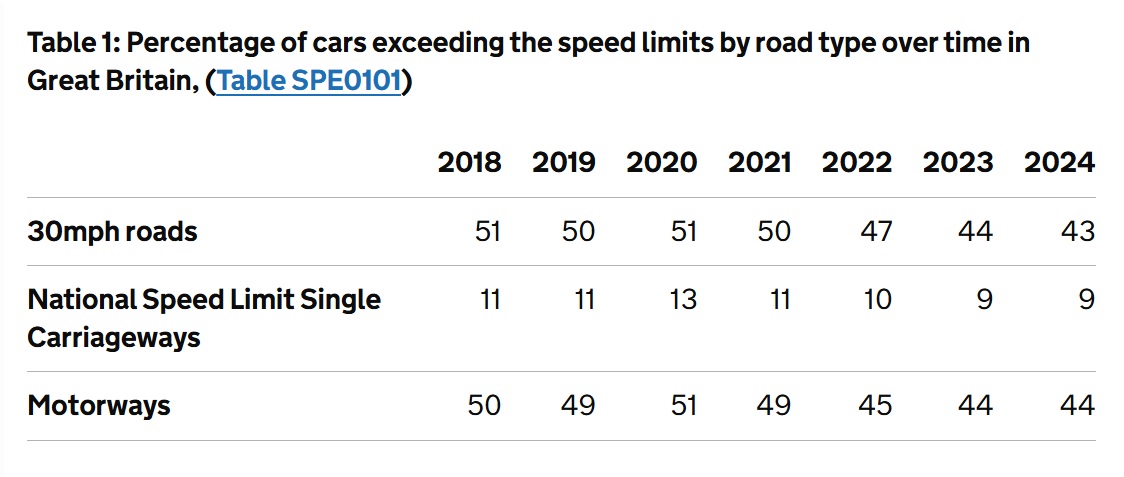
The percentage of car drivers exceeding the speed limit on motorways and 30mph roads fell during 2024 – continuing the broadly downward trend seen since 2018.
That’s according to Government statistics, which measure speed and compliance at sites where the road conditions are ‘free flowing’ – for example roads with no junctions, hills, sharp bends, speed enforcement cameras or other traffic calming measures.
In 2024, the data shows that 44% of car drivers exceeded the speed limits on motorways, compared to 50% in 2018.
It is a similar picture for 30mph roads, where 43% of car drivers exceeded the speed limit in 2024, compared to 51% in 2018.
Meanwhile on National Speed Limit Single Carriageways, 9% of car drivers were found to be exceeding the speed limit in 2024, compared to 11% in 2018.

Image: DfT
Looking at more extreme instances of speeding, 7% of car drivers on motorways were found to be exceeding the speed limit by more than 10mph. On 30mph roads, the equivalent figure was 4%.
Meanwhile on 20mph roads, 76% of cars exceeded the speed limit, and 10% exceeded the speed limit by more than 10mph.
While these figures may seem alarming, the DfT stresses that free flowing conditions are not typical of most 20mph roads. DfT guidance suggests that 20mph limits are most effective when they have traffic calming measures.
The dataset also looks at other vehicle types.
When it comes to light commercial vehicles (LCVs), 45% were found to be exceeding the speed limit on 30mph roads, at 47% on motorways.
With motorcyclists, 48% exceeded the speed limit on 30 mph roads, 24% did so on NSL single carriageways and 53% did so on motorways.
Data previously published shows:
- in 2022, 2.52 million drivers were issued with a fixed penalty notice for speeding offences, this is a 6% increase when compared to the previous year, and an increase of 69% since 2011
- in 2024, 205,522 people were found guilty of a speed limit offence, this is an increase of less than 1% when compared to the previous year, but an increase of 87% since 2011
- in 2024, 1.84 million drivers attended a speed awareness course in the UK, this is a 3% increase when compared to the previous year, and an increase of 139% since 2011
Dangerously poor quality road surfaces network wide and the proliferation of blindingly bright headlights in use at night are two reasons why I’ve had to drive slower.
I guess risk compensation is real.
Hugh Jones, Newcastle upon Tyne
+1
Precisely, @Hugh Jones. That was my exact experience driving a new, quite basic, hired car with an automatic gearbox and ISA around the Scottish Highlands and Islands recently. The car itself pretty much drove itself. It knew what the speed limit was (with 1 or 2 minor exceptions), where the bends were and the safe speed to drive round them and whether there were slower vehicles in front. It could even detect junctions and automatically slow sufficiently to turn left (I use the passive case, as IT drove me, rather than other way round). I didn’t risk letting it turn right, btw! Compliance with speed limits for those that want to comply will become much easier and that, in turn, will help those behind to comply, even if they don’t want to. Oh, and by the way, it puts to bed the statement that “my car won’t go at 20mph…”
Adrian Berendt, Tunbridge Wells
0
I think this may be down to less and less vehicles on our roads having manual gearboxes due to the increase in EVs and automatics generally. Such vehicle seem to induce a better standard of driving. No speed is inconvenient in these vehicles and their speed is not being dictated by constantly having to change up or down to seek a balance between engine revs and vehicle speed.
Hugh Jones, South Wirral
--1
We have always said that “absolute compliance” is rather a blunt measure.
On 20mph lets put this into perspective. There were only 9 sites across the whole of the UK which were chosen as not having residential housing, shops, crossings or similar features. The average count of vehicles observed was just 1,690 per site. Even on these “free-flowing” sites which the DfT said were “atypical” of most 20mph roads, the average speed was 24mph and 6mph less than equivalent roads with a 30mph limit. Moreover on these 9 sites the number of cars absolutely complying with the 20mph limit had increased from 19% in 2018 to 24% in 2024. A 25% increase in compliance.
Whilst the DfT does suggest that 20mph limits are most effective when they have traffic calming measures, once the cost of physical calming is taken into account, 20mph limits without physical calming are 7 times more cost effective in reducing speeds per km of road per £1,000 spent. See this briefing sheet https://www.20splenty.org/20mph_limits_vs_isolated_20mph_zones
And as so many councils and countries are finding, a 20mph limit as a norm with exceptions to 30mph is a sound investment that pays back in £s, liveability, public health and road safety in so many ways. All the data shows that the casualties and disadvantages of a general 30mph urban/village speed limit are no longer acceptable.
Rod King, Lymm
--3